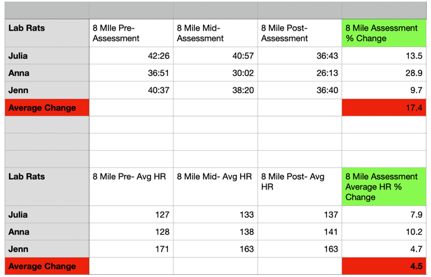Mini Study: Pre-Season Mountain Bike Program Produces an Average of 17.4% Faster 8 Mile Time
By Anna Woodring, MTI Head Strength & Conditioning Coach/Researcher
BLUF
Mountain bike pre-season training program led to an average of 17.4% change in overall performance, resulting in a faster 8-mile assessment for all lab rats.
Background
Going into this mini-study, we hoped to learn…
- The effectiveness of using zone-based heart rate programming for base training days.
- The ability and functionality of an athlete to stay within a prescribed heart rate zone while mountain biking.
- Transferability of utilizing time trial training rides vs culminating 30-mile ride.
Mini-Study Design
Three lab rats completed a 5-week/ 6 days a week mountain bike preseason plan in Boise, Idaho. The 8-mile assessment was tested pre-cycle, mid-cycle, and post-cycle. The assessment was conducted on a single-track, relatively flat, paved route. Lab rats took their average heart rate from each 8-mile assessment and utilized a progressive percentage range for base training days. Lab rats were instructed to stay within the percentage of +/- 5 beats per minute for training sessions each week.
The program looked to meet the following objectives:
(1) Increase pedaling power and speed over ground
(2) Increase bike-specific leg strength, core strength, and upper body strength
(3) Increase volume biking fitness and recovery.
Below was the weekly schedule:
Mon: Assessment or Base Training
Tue: Strength Training
Wed: Base Training
Thu: Hill Repeats
Fri: Build Training
Sat: Long MTB Ride
Sun: Total Rest
Base training days were structured to maintain each lab rat’s average heart rate at 80% of their respective heart rate measured during the 8-mile assessments. Heart rate was used as the “governor”, not allowing lab rats to go over or under their individual zone to facilitate easy recovery rides.
Strength training sessions incorporated exercises such as mini and full leg blasters, scotty bobs, chassis integrity grinds, and strength endurance calf work. The number of rounds and the duration of the grind time progressed each week to enhance training intensity.
Hill repeat days entailed continuous uphill climbing for a duration of 5 minutes, followed by 3-5 minutes of rest. The number of rounds progressively increased each week.
Build training days followed a similar structure to base training but with a higher target heart rate percentage of 90%.
The long mountain bike ride duration gradually increased from 75 minutes to 120 minutes, maintaining a moderate pace throughout the training period
Results & Discussion
Based on this mini-study the pre-season mountain bike program produced an average of 17.4% decrease in 8-mile assessment time.
The application of using a heart rate-based training zone necessitated a reduction in our usual training pace, which helped us achieve sufficient recovery—an aspect that many of us struggle to prioritize during training sessions. This slower pace was comfortable for each of us and ensured our easy rides remained truly easy. By adhering to this prescribed slower pace, we were able to effectively restore our physiological systems and mitigate the potential drawbacks associated with excessive training intensity.
Implementing the use of heart rate zones while mountain biking on a single track proved to be relatively straightforward. Staying within my designated zone while riding was easier than staying within a prescribed zone for other activities such as aerobic base running. While we occasionally experienced heart rate spikes on certain hills, we were able to swiftly lower it and maintain better regulation overall than expected.
Julia and I, exhibited a notable increase in average heart rate from our pre-assessment to post-assessment, accompanied by improved time performance in the latter assessment. The presence of leg fatigue emerged as a significant factor, limiting our ability to attain higher heart rates due to premature leg exhaustion. It is worth noting that we both originated from a predominantly running-focused background, which likely influenced our response during the assessments.
Of particular significance was the hill repeat training day, which posed the greatest challenge and held potential importance. Over the course of several weeks, we demonstrated an improved ability to maintain a higher cadence and ascend further up the mountain. These advancements, in conjunction with dedicated strength training sessions, yielded reduced leg fatigue during subsequent assessment days, thus addressing the previously observed limiting factor identified during the initial assessment.
Our culminating event concluded with a demanding 30-mile bike ride that entailed ascending to an elevation of 4,000 feet. Lab rat Julia achieved an impressive feat by securing the seventh fastest time among women for one of the mountains within the 30-mile ride.
The training program successfully translated into the 30-mile ride, yielding easier climbs and improved speed for all participants. Julia’s performance, in particular, demonstrated significant progress, surpassing her previous records. Notably, Julia acknowledged her tendency to exert excessive effort in past training sessions, neglecting the importance of prescribed easy base rides. By staying within the prescribed heart rate zones, she experienced better weekly recovery and an overall increase in performance.
Post-ride soreness was observed as a potential consequence of the increased volume compared to previous rides. The longest ride prior to the 30-mile ride was an hour shorter in duration. To mitigate this issue, incorporating more long rides throughout the program could have facilitated better adaptation and minimized soreness by allowing our bodies to adjust in advance.
Next Steps
The subsequent phase of the study will involve the evaluation of power-based training utilizing an outdoor power meter during mountain biking. The efficacy of power-based training has already been demonstrated in indoor settings, yielding commendable outcomes. It will be interesting to determine the comparative effectiveness between heart rate training and power-based training when applied to the challenging outdoor terrain of mountain biking. By examining the outcomes of both approaches in this context, valuable insights can be gained regarding which method yields superior results in terms of performance and overall training effectiveness.
Comment below or send your questions/feedback to anna@mtntactical.com
STAY UPDATED
Sign-up for our BETA newsletter. Training tips, research updates, videos and articles - and we’ll never sell your info.


